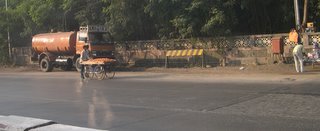Some parts of Mumbai suffer from water shortage. Even if there was a record rainfall, we keep reading about the shortage of water supply in the newspapers. Many rely on water tankers (also called "water suppliers") to supply additional water. This happens in middle-class housing societies. Some reports in newspapers recently also pointed to water supply shortage in the upper-class high-rises at Malabar Hill.
I have observed plenty of construction activity in the Powai area. Many buildings under construction (and even those that are complete) receive water from these tankers. Now the question naturally arises: how and from where do these water suppliers get their water from?
A very villiany guess would be that maybe these suppliers pay some additional money (aka bribe) to the powers-that-be and get additional water pipelines into their compounds. They can then "sell" this water (obviously at a much higher rate) to the people who need it. In other words, an "artificial need" is created by taking more than needed and giving to others less than wanted.
Or maybe not...maybe these suppliers are legitimate people operating as per the rules of the game. Maybe they have a borewell and that is perfectly legal.
All that is fine to say, but the mind refuses to be convinced. For many years, I've been seeing the Powai lake frequently. It seems to me that the lake levels went down substantially last summer (2005). One could see vast patches of dry land with grass (cows were grazing in the lake periphery). Maybe the summer was really harsh. Or...maybe someone is stealing water from the lake.
An article in Mumbai Mirror in June makes the author of the article feel that the stealing of water has stopped. Maybe the author should go and re-investigate (a journalist's job is to investigate the matter...not ours...but we do it out of fun).
Think, think, think. Okay, open your eyes as you travel every morning from Powai lake towards Gandhinagar. On the right hand side (on the opposite side of the lake), just after the Shipping Corporation gate, one can spot some of these tankers lined up. They are getting filled in with the water. The source of the pipe seems to be somewhere inside the complex. Is the pipe connected below the surface of the road to the lake?
Go and find out, Piali Banerjee.

